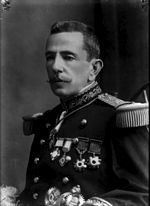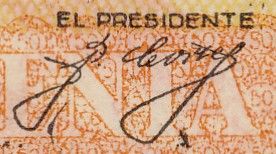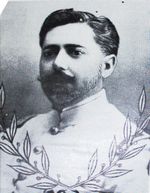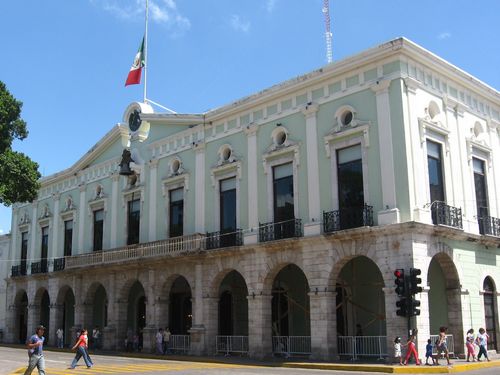First issue
On 22 July 1914 the board of the Comisión Reguladora, chaired by the Governor, discussed the lack of fractional currency and the speculation with low value banknotes. The local Cámara de Comercio and a group of hacendados had asked it to issue notes and the Comisión decided to ask for permission to make an issue of $500,000 in cartones of 10c, 20c and 50c, guaranteed by the funds that the cheques themselves would raise. The state Congress discussed the matter at their regular meeting on 24 July and agreed a proposal for the Comisión to issue up to $1,000,000 in cheques for those valuesDiario Oficial, Yucatán, 17 August 1914. The governor, Prisciliano Cortés, had just ordered that private vales should be withdrawn but the Comisión (and the Cámara de Comercio) argued that it was a dependency of the state.
By decree núm. 132[text needed], on 25 July, Cortés authorized the Comisión to issue up to $1,000,000 in notes of the three values (10c, 20c and 50c), though in the event only 20 and 50 centavos notes were issued,
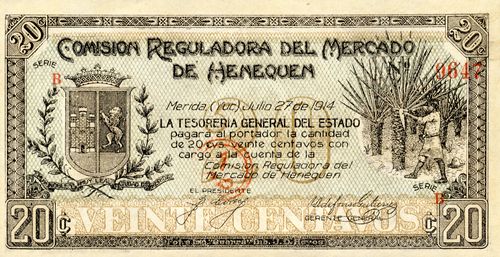
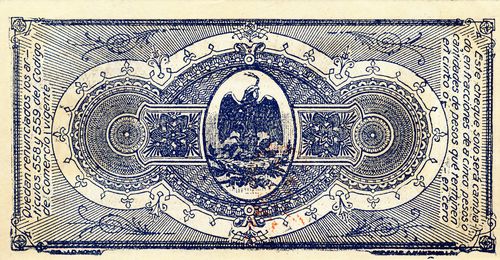 M4155a 20c Comisión Reguladora
M4155a 20c Comisión Reguladora
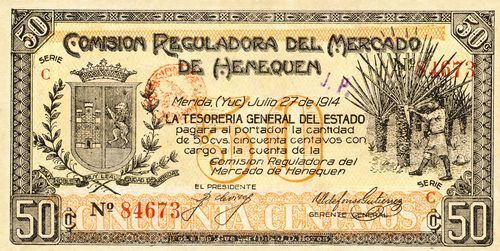
 M4156a 50c Comisión Reguladora
M4156a 50c Comisión Reguladora
| Series | from | to | total number |
total value |
||
| 20c | A | 1 | 100000 | 100,000 | $ 20,000 | |
| B | 1 | 100000 | 100,000 | 20,000 | ||
| C | 1 | 100000 | 100,000 | 20,000 | ||
| D | 1 | 100000 | 100,000 | 20,000 | ||
| E | 1 | 100000 | 100,000 | 20,000 | ||
| F | 1 | 100000 | 100,000 | 20,000 | ||
| G | 1 | 100000 | 100,000 | 20,000 | ||
| H | 1 | 100000 | 100,000 | 20,000 | ||
| I | 1 | 100000 | 100,000 | 20,000 | ||
| J | 1 | 100000 | 100,000 | 20.000 | ||
| 50c | A | 1 | 100000 | 100,000 | 50,000 | |
| B | 1 | 100000 | 100,000 | 50,000 | ||
| C | 1 | 100000 | 100,000 | 50,000 | ||
| D | 1 | 100000 | 100,000 | 50,000 | ||
| E | 1 | 100000 | 100,000 | 50,000 | ||
| F | 1 | 100000 | 100,000 | 50,000 | ||
| G | 1 | 100000 | 100,000 | 50,000 | ||
| H | 1 | 100000 | 100,000 | 50,000 | ||
| I | 1 | 100000 | 100,000 | 50,000 | ||
| J | 1 | 100000 | 100,000 | 50,000 | ||
| K | 1 | 100000 | 100,000 | 50,000 | ||
| L | 1 | 100000 | 100,000 | 50,000 | ||
| M | 1 | 100000 | 100,000 | 50,000 | ||
| N | 1 | 100000 | 100,000 | 50,000 | ||
| O | 1 | 100000 | 100,000 | 50,000 | ||
| $950,000 |
Later on Alvarado acknowledged only the 50c Series A – ODiario Oficial, Yucatán, Año XIX, Núm. 5647, 4 April 1916 but a Series P (1 -100000) seems to have been issued (the printing of the letter ‘P’ is poor).
These were designed by J. D. Hoyos with the coat-of-arms of the city of Merida and a vignette of henequen cultivation, photoengraved by Armando Manzanilla and printed by Fot. e Imp. “Guerra”. On the face they stated that the Tesorería General would pay them to the account of the Comisión, and on the reverse that they were redeemable in multiple of five pesos and and that articles 558 and 559 of the current Codigo de Comercio (of 1912) referring to the time-limit for presenting a cheque for payment did not applyArticle 558 stated "El tenedor de un cheque deberá presentarlo para su pago dentro de los ocho días inmediatos á su fecha, si fuere girado en la misma plaza. A ese término se agregará un día por cada 100 kilómetros de distancia entre el lugar del giro y el del pago, cuando éstos fueren distintos" and article 559 “El tenedor ó dueño e un cheque no presentado dentro del término legal, perderá todas sus acciones y derechos contra el librador, si por quiebra ó suspensión de pagos del librado, posteriores á dicho término, dejare de cubrirse aquel documento”.. They were signed by Prisciliano Cortés as president (Presidente) and Idefonso Gutiérrez as general manager (gerente General).
Thereafter the amount in circulation grew. By decree núm. 42, on 20 November 1914, the new governor, Eleuterio Avila authorized a further five million pesos in $1 and $5 notesDiario Oficial, Yucatán, Año XVII, Núm. 5226, 23 November 1914.
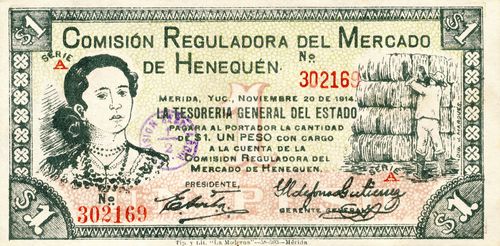
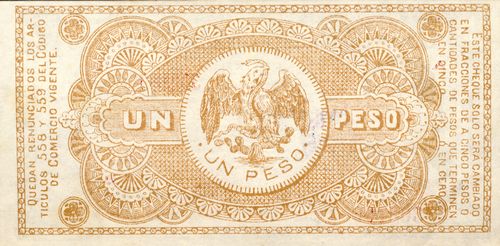 M4157a $1 Comisión Reguladora
M4157a $1 Comisión Reguladora
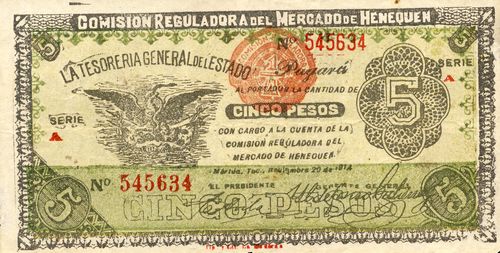
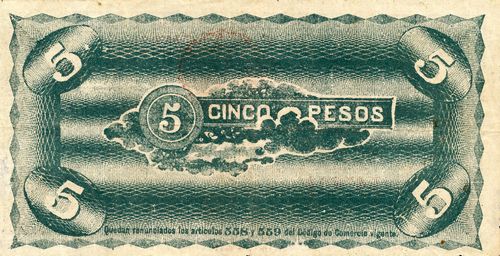 M4158a $5 Comisión Reguladora
M4158a $5 Comisión Reguladora
Later, his successor Salvador Alvarado acknowledged four million pesos’ worthDiario Oficial,Yucatán, Año XIX, Núm. 5647, 4 April 1916.
| Series | from | to | total number |
total value |
||
| $1 | A | 000001 | 1000000 | 1,000,000 | $1,000,000 | includes numbers 002526CNBanxico #12397 to 982402 |
| $5 | A | 1 | 600000 | 600,000 | 3,000,000 | includes numbers 058764CNBanxico #6544 to 545634 |
| $4,000,000 |
These had similar designs and text but were now signed by Avila as president, together with Gutiérrez.
|
During his tenure he passed decree nullifying the debts of peons and changing the functions of the Comisión Reguladora del Mercado del Henequén although this did not take full effect until Salvador Alvarado took over the governorship. In January 1915, just over four months after arriving in Yucatán, Avila went to meet with Carranza in Veracruz to discuss a henequen tax that Luis Cabrera wanted to impose, and never went back. During his absence Abel Ortiz Argumedo revolted against Avila's successor, General Toribio de los Santos, and Carranza named Salvador Alvarado to counter Argumedo and, on his victory, to take over the governorship. Avila died in 1948. |
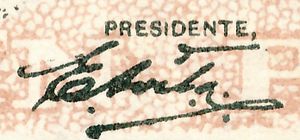 |
| Ildefonso Gutiérrez was retained by the incoming Constitucionalists as Gerente General, though some felt that the ex -federals in Yucatán were undermining their cause. Gutiérrez was accused by Alfredo Becerra that in the last days of Huerta’s regime he had sent $2,000,000 to Huerta for military expenses and after Huerta had left the country still sent $1,000,000 to the henequen capitalists to support the press campaign maintained from Havana. New Orleans and other places. He also contributed $10,000 to the governorCEHM, Fondo XXI, carp. 6, leg. 752 letter Alfredo Breceda, Mérida to Carranza, Veracruz, 14 August 1914. |
These were printed by the Tipografía "La Moderna".
On 12 December 1914 Carranza, as Primer Jefe, argued that the Comisión Reguladora needed the necessary resources to fulfill its aims and authorized it to issue up to ten million pesos ($3,000,000 in $5; $3,000,000 in $10; $2,000,000 in $20; and $2,000,000 in $50). These would be of forced circulation in Yucatán and in Campeche, if the Comisión Reguladora extended its operations thereDiario Oficial, Yucatán, 16 December 1914. This appears to be part of Carranza’s continuing attempt to keep some sort of federal control over the local issues made in the areas that his forces, at least nominally, dominated. It was only partly successfully because when, on 11 January 1915, by decree núm. 57, Avila added a series of $20 notes, he authorized four million pesos, twice the amount mentioned by CarranzaDiario Oficial, Yucatán, Año XIX, Núm. 5272, 11 January 1915. These $20 notes are still dated 20 November 1914, even though the decree was 11 January 1915.
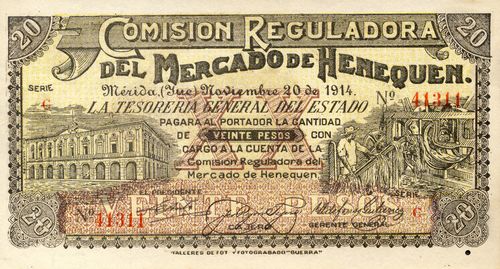
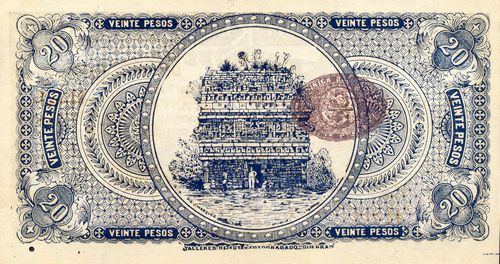 M4159a $20 Comisión Reguladora
M4159a $20 Comisión Reguladora
| date of issue | Series | from | to | total number |
total value |
||
| $20 | 15 January 1915 | A | 1 | 100000 | 100,000 | $2,000,000 | includes number 99795CNBanxico #6549 |
| 26 January 1915 | B | 1 | 100000 | 100,000 | 2,000,000 | includes number 56041CNBanxico #12401 | |
| $4,000,000 |
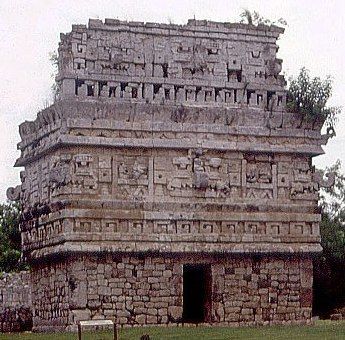
The vignette on the front is of the Palacio de Gobierno in Merida and reinforces the official status of the issue. The vignette on the back is of a Mayan structure at Chichen Itza called La Iglesia. The signatories are Eleuterio Avila as Presidente, Joaquín Rejón Tejero as Cajero and Ildefonso Gutiérrez as Gerente General.
| Eleuterio Avila | |
| Joaquín Rejón Tejero | 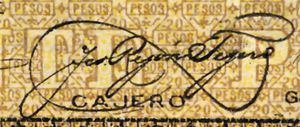 |
| Ildefonso Gutiérrez |
The notes were produced by the Talleres de Fotografía y Fotograbado "Guerra".
According to Ildefonso Gutiérrez, the general manager of the Comisión Reguladora, Series A notes were placed into circulation on 15 January (the same day as the decree) and Series B by 26 January.
On 27 January Avila was suspended for suspected disloyalty (some believed that he had become too close to the henequen oligarchy) and replaced by a new governor, General Toribio de los Santos. In his short term as governor, historians suggest that de los Santos seemed to be much more committed to reform than Avila and thereby more of a threat to the planter class. Wells and JosephAllen Wells and Gilbert M. Joseph, Summer of Discontent, Seasons of Upheaval: Elite Politics and Rural Insurgency in Yucatán, 1876-1915, Stanford University Press, 1996 argue that de los Santos ‘‘breathed new life into Avila’s moribund peonage decree, rescinding all the riders that had previously nullified its impact and outlawing the system of payment in scrip that underwrote the hacienda store.’’ Santos dispatched Colonel Abel Ortiz Argumedo to quell an uprising in Temax but Argumedo recruited the rebels and deposed Santos, capturing Mérida on 12 February and appointing himself governor.

